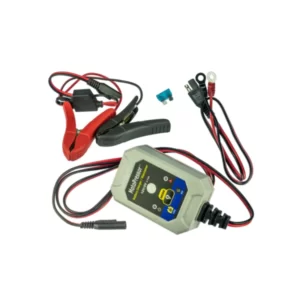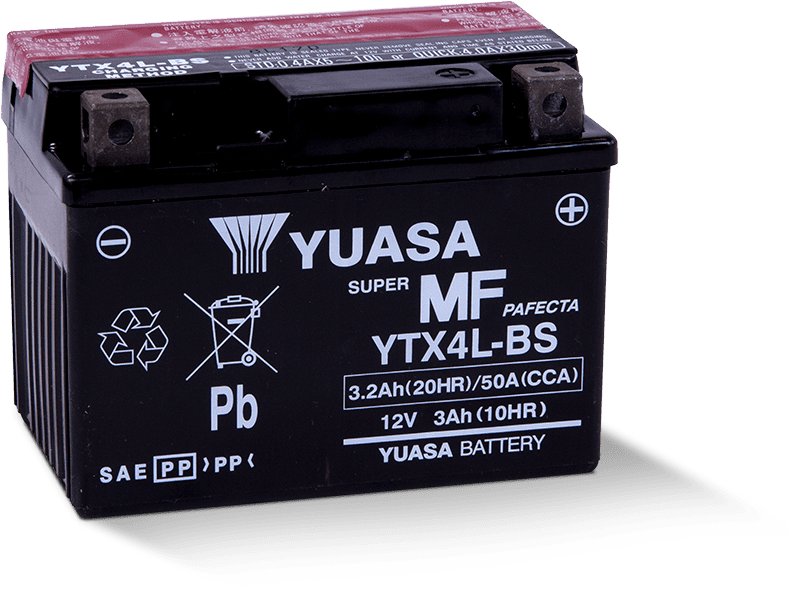Prepare your battery for springtime start-up confidence
Winter is coming.
For many of us, it’s time to put our motorcycles away until the warmer weather returns.
How long your bike will be in a state of suspended animation depends on the outside temperature and your willingness to ride—or not—in cold weather.
Whether your motorcycle is going to be idle for a month or the entire winter, the expectation that all riders have is that when that first nice day comes around in spring you are going for a ride.
You insert the key, turn on the ignition, and just before you press the start button a quick thought enters your head, “I hope the battery is charged!” Too often many of us get a dose of reality when the start button is pressed and nothing happens.
Jump-starting or charging are options, but will there be enough electrical juice to start the engine again? Dead batteries are frustrating.
Motorcycle Battery Freezing
Caring for your motorcycle’s battery over the winter months is simple if these two rules are followed: Keep the battery stored out of the freezing cold environment and keep the battery charged.
There is a direct relationship between a battery’s state-of-charge and the temperature at which it will freeze. The electrolyte in a battery is made up of a combination of sulfuric acid and water. When a battery becomes discharged, the percentage of acid to water changes to mostly water, which will freeze at a higher temperature than acid. Freezing can crack the battery’s case and buckle the plates, permanently damaging it.
A fully charged battery can be stored at subfreezing temperatures (down to -75° F) with no damage. By contrast, a discharged (dead) battery will freeze at only 27° F. A battery not connected to anything can lose up to one percent of its charge each day at 70° F and more as the ambient temperature drops.
If the battery is installed on a motorcycle, electronic fuel injection computers, clocks, and radios can drain the battery at higher rates even when the ignition is off. Conventional batteries (the ones with filler caps) need to be checked for state-of-charge every month and absorbed glass mat (AGM) batteries, called maintenance-free, about every three months. Temperatures below 60° F or above 80° F may require more frequent inspections and/or charging.
To check battery state-of-charge, connect a digital voltmeter and read the voltage. If it’s less than 12.25 volts, it’s time to charge the battery.
Winter Storage Battery Chargers
Yuasa’s Automatic One AMP Battery Charger and Maintainer (#YUA1201000) is a great choice for winter storage. It can charge and maintain an AGM or Conventional flooded battery. It uses a three-stage charging cycle and has an LED display to indicate charge status. The charger can be left connected to a battery all winter and will not overcharge it.
The AMP Battery Charger and Maintainer has reverse polarity protection, so even in case the battery is incorrectly connected, there will be no damage to either the charger or battery. The cable is 12 feet long and the charger comes with a quick-disconnect fused ring connector that can be installed directly to the battery. The charger retails for $40.95 and comes with a 5-year limited warranty.
The first step you can try to keep your motorcycle battery charged during the winter is hooking your battery up to a battery tender.
Please note that a battery tender is different from a trickle charger which we will cover later.

Battery Tender
A battery tender is a device you can hook up to your motorcycle battery indefinitely throughout the winter. It has a sensor on it that will notify the system that the battery is starting to lose it’s charge and will automatically start charging it. Once it senses the battery is up to a full charge, it will automatically stop charging to prevent an overcharge. You essentially can let it do all the work without a worry.
Some people worry that the battery tender itself may freeze in the cold temperatures and fail to charge the battery. In most cases, you don’t need to worry because battery tenders are plugged in which prevents them from freezing.
The second option you have is using a trickle charger. A trickle charger and a battery tender both charge motorcycle batteries, but a trickle charger is different because it gives a constant charge rather than turning on and off like a battery tender.
Motorcycle Trickle Charger
If you use a trickle charger, you’ll need to supervise the charge to ensure it does not overcharge the battery. It is completely possible to overcharge a battery and is evident if the motorcycle battery itself starts swelling and it becomes hot to the touch.
You can use the trickle charger method occasionally and it will prolong the health of your motorcycle battery just fine. Hook the trickle charger up to the battery every few weeks or every other month and check in on the battery while it’s charging so it doesn’t get overcharged.
3rd Option
The third option you have to keep your motorcycle battery charged during the winter is simply disconnecting it from the battery and bringing it inside where it remains in controlled temperatures until spring.
If you choose this option, make sure to put it in some sort of container to prevent anything from falling on it or in the case it tips over and leaks. Always keep it away from any source of heat.
While keeping your motorcycle battery inside during the winter, it will still slightly discharge, but not as much as it would remaining outside. You can either continue to occasionally charge it throughout the winter (but make sure you do so outside) or you can simply wait until spring to charge it.
Additional Motorcycle Battery Maintenance During The Winter
Aside from keeping the battery charged, there are several other things you can do to maintain and prolong the life of your motorcycle battery. These are things people often forget to check.
Be sure to occasionally check the battery cables and ensure they are not cracked or have become brittle. The exposed wires underneath can cause a short and drain the battery even quicker. If you plan on keeping your motorcycle battery connected to the motorcycle throughout the winter, make sure the connectors are always tight so dirt or dust doesn’t get in between and lessen the connection.
Any time you are handling the motorcycle battery, always use insulated tools (tools that have rubber casings around the handles) so you don’t end up shorting the terminals.
Make sure to not let your motorcycle battery lose more than 20% of it’s charge (or the charge doesn’t get below 80%). If it gets below this, it may lose it’s capacity to charge fully.
It’s also a good idea to always inspect the terminals and make sure there is no acid build up on them. It’s fairly common for this to happen, but this prevents a full connect from the cables and could potentially cause problems.
What Happens To A Motorcycle Battery During The Winter
Just like us humans, harsh weather conditions can be rough on motorcycle batteries. Unfortunately, it is completely possible for a motorcycle battery to freeze.
Cold temperatures can inhibit a motorcycle battery’s ability to start a motorcycle. When a motorcycle has been exposed to cold temperatures for a certain amount of time, the oil inside the engine can lose some of it’s viscosity which makes the movement of the pistons a lot more difficult.
This, in turn, requires more power to get the motorcycle started in the first place. More power needed from an already inhibited, cold battery almost becomes impossible.
There is no exact temperature that can tell at what point a motorcycle battery can freeze. All of that depends on how charged or discharged the battery is. Much colder temperatures will be needed in order to freeze a fully charged motorcycle, while a discharged battery can freeze at just below freezing temperatures.
It’s important to know that a fully discharged battery doesn’t mean it has zero voltage. A completely discharged battery means it has anything below 12 volts whereas a 100% charged battery should read 12.6 volts. So if you use a multimeter and notice your battery is below 12 volts, you know you’ll promptly need to charge it.
On top of the freezing temperatures hindering the functionality of a motorcycle battery, they also suffer from a phenomenon called parasitic drain.
The battery gets a normal, routine charge every time you ride your motorcycle because of the stator. The battery is only used to start the motorcycle and the stator continues to charge the battery while the motorcycle is running
The winter usually mean you’ll be using your motorcycle a lot less than you have been during the warm months. Because the motorcycle battery isn’t getting the normal charge during rides, parasitic drain, or poorly grounded wires that slowly discharge the battery, starts to take place. See how a motorcycle battery gets charged during rides by clicking here to my article.
Can A Cold Winter Destroy A Motorcycle Battery?
There may be some of you who didn’t know that a motorcycle battery required maintenance throughout the winter and may have done nothing throughout the cold months.
If you’re at this point, or simply just curious, you may be wondering if a single cold winter could destroy or ruin a motorcycle battery if no maintenance or charging was performed on it. A lot of this depends on how cold the temperatures were, how old the battery was, and how discharged the battery was.
There does come a point where you will simply need a new battery. If your battery was a few years old and didn’t have much of a charge to begin with during the winter, chances are the battery has been ruined and you will need a new one. You can easily test the life of your battery through a multimeter. If you’re curious about whether or not a motorcycle battery can freeze, see my article here.
Related Questions

How long can a motorcycle sit before the battery dies?
How long can a motorcycle sit before the battery dies? The average motorcycle battery will die after 2 – 4 months without running. Newer batteries can last longer with an average of 3 – 5 months until dying whereas older batteries will have an average of 1 – 3 months until the battery dies while the motorcycle is sitting. Click here for more info.
Can you jump start a motorcycle from a car? It is possible to jump start a motorcycle using a car. However, there is a risk of ruining the motorcycle battery if it is done wrong. Leave both vehicles off while connecting the jumper cables. Once connected, leave the car off and attempt to start the motorcycle.